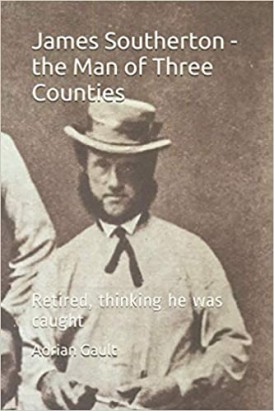James Southerton – The Man of Three Counties
Martin Chandler |Published: 2020
Pages: 111
Author: Gault, Adrian
Publisher: Mitcham Cricket Club
Rating: 3.5 stars

The name of James Southerton is not an unfamiliar one. A combatant in the first ever Test match back in 1877 he remains, at 49 years 119 days, the oldest debutant in Test history and, just over three years later, he became the first Test cricketer to depart this mortal coil.
I did know a little more than those basic facts about Southerton before I read this long overdue biography from Adrian Gault, but not much, and I am most grateful to Gault for telling me the story of an interesting man and a cricketer who was, in his day, a very successful bowler.
Writing a biography of a man who died almost a century and a half ago, with no descendants to assist, is a challenge. The relative ease with which the press reports of the time can now be accessed makes the task more manageable than it once was, but that in itself creates a trap, that of becoming mired in the generally somewhat colourless prose that appeared in newspapers and magazines in Victorian times.
Born in Petworth in West Sussex in 1827 Southerton’s early life is reconstructed skilfully from the available records, and his cricket career explained. Initially he seems to have been more of a batsman than a bowler before becoming a modest all-rounder. It was not until Southerton was all but 40, and abandoned his above medium pace trundling, that he suddenly became a conspicuously successful slow round arm bowler who spent a decade at the top of the game.
Twice, in 1873/74 and 1876/77, Southerton toured Australia and, being an intelligent man, he provide ‘reports’ on the tour for the English press. The touring experience in those days was not remotely like it is today, nor as it would be once the MCC took over the organisation of Test tours in 1903/04, and the two chapters which cover these trips and outline the actions of the private promoters who put them together are the two most interesting in the book.
Back in England, as the book’s subtitle suggests, Southerton played his county cricket at various times for Surrey, Sussex and Hampshire. The rigid qualification rules that characterised the English game for many years came into being because of the controversies that regularly cropped up during Southerton’s time and his movements between his three counties are another absorbing feature of the account of a man who was clearly not reluctant to use the civil courts when he believed he had been wronged.
So does Gault avoid the trap I referred to? I am pleased to report that he does. James Southerton – The Man of Three Counties does make use of quotes from contemporary sources and descriptions of cricket matches, but there is much more besides. Gault is a Mitcham man through and through and we have reviewed a couple of his previous books here and here. The research for those clearly helped him as, in addition to his county career, Southerton had a long association with Mitcham.
As a result of what must have been a great deal hard graft it is difficult to imagine that much more could have been uncovered, and Gault’s account of Southerton’s life is certainly a detailed and, more importantly, well written one. It is also pleasing to note that he is not afraid to accept where he has not been able to find answers, and he does on occasion venture his own opinion on or question the ‘facts’ he has uncovered.
I was also impressed by the way in which the closing chapters are put together. In those Gault pulls together what has gone before and sets out his conclusions about Southerton the cricketer and, rather trickier, but equally well done, Southerton the man.
All in all James Southerton – The Man of Three Counties has a splendid narrative and can be purchased through Amazon, although the publishers are the Mitcham Club, who will reap the benefits of the revenue the sales generate. The production standards of the book do leave a little to be desired, although I appreciate the reason why the Amazon platform is used. Despite that I am sure it must have been possible for the text to be fully aligned, and the presentation overall would have benefitted from some input from a designer. That is but a minor grumble however, and I commend this one to all






Leave a comment